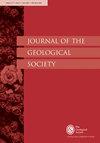青藏高原东北部南祁连增生带东南部不同类型海洋板块地层识别
IF 3
3区 地球科学
Q2 GEOSCIENCES, MULTIDISCIPLINARY
引用次数: 0
摘要
对造山带海洋板块地层学(OPS)遗迹的解剖可以为海洋演化、造山带形成和大陆生长提供重要的认识。本文对南祁连增生带(SQAB)岩石学、年代学、地球化学和Sr-Nd同位素进行了研究,旨在为原特提斯洋(PTO)的演化提供新的约束条件。通过岩石学、地球化学和同位素特征的差异,可以识别出三种类型的OPS单元。1型OPS为海洋岛屿/海山遗迹,由oib型玄武岩、辉长岩(t = 525±4 Ma, (87 Sr/ 86 Sr) i = 0.7035 ~ 0.7039, ε Nd (t) = +3.63 ~ +4.16)和(硅质)碳酸盐岩组成。2型OPS为正常洋壳碎屑,由n - morb型玄武岩和玄武岩安山岩((87 Sr/ 86 Sr) i = 0.7059 ~ 0.7063, ε Nd (t) = +6.33 ~ +7.44)、燧石岩和硅质泥岩组成。3型岩体可能为海洋高原成因,由e- morb型玄武岩和玄武岩((87 Sr/ 86 Sr) i = 0.7051 ~ 0.7064, ε Nd (t) = +4.81 ~ +6.24)、碳酸盐-硅质泥岩和碳酸盐岩组成。这些OPS见证了专利商标局的演变。根据已有的区域弧型岩浆活动研究和碎屑锆石U-Pb年代学资料,提出了“OPS增生引起的沟塞伴俯冲翻转”模型。专题收藏:本文是蛇绿岩、杂岩和蓝片岩收藏的一部分,可在:https://www.lyellcollection.org/topic/collections/ophiolites-melanges-and-blueschists补充材料:https://doi.org/10.6084/m9.figshare.c.6764637本文章由计算机程序翻译,如有差异,请以英文原文为准。
Recognizing different types of Ocean Plate Stratigraphy at the southeastern South Qilian Accretionary Belt, northeastern Tibet Plateau
Dissection of relicts of Ocean Plate Stratigraphy (OPS) at orogens could provide important insights into oceanic evolution, orogenic formation, and continental growth. Here we put forward a study of petrology, geochronology, geochemistry, and Sr–Nd isotopes for OPS at the South Qilian Accretionary Belt (SQAB) with aim to provide new constraints on evolution of the Proto-Tethys Ocean (PTO). Three types of OPS units were recognized by their discrepant petrological, geochemical, and isotopic features. Type 1 OPS as relicts of ocean islands/seamounts comprises OIB-type basalt and gabbro (t = 525 ± 4 Ma, (
87
Sr/
86
Sr)
i
= 0.7035–0.7039, and ε
Nd
(
t
) = +3.63 to +4.16) and (siliceous) carbonate rocks. Type 2 OPS, representing fragments of normal oceanic crusts, consists of N-MORB-like basalt and basaltic andesite ((
87
Sr/
86
Sr)
i
= 0.7059–0.7063, and ε
Nd
(
t
) = +6.33 to +7.44), chert, and siliceous mudstone. Type 3 OPS could be oceanic plateau-derived and comprises E-MORB-like basalt and dolerite ((
87
Sr/
86
Sr)
i
= 0.7051–0.7064 and ε
Nd
(
t
) = +4.81 to +6.24), carbonate-siliceous mudstone, and carbonate rock. These OPS witnessed evolution of the PTO. By available studies on regional arc-type magmatism and U-Pb geochronological data of detrital zircon in this study, a model of “trench jam accompanying with subduction flip induced by accretion of the OPS” is put forward.
Thematic collection:
This article is part of the Ophiolites, melanges and blueschists collection available at:
https://www.lyellcollection.org/topic/collections/ophiolites-melanges-and-blueschists
Supplementary material:
https://doi.org/10.6084/m9.figshare.c.6764637
求助全文
通过发布文献求助,成功后即可免费获取论文全文。
去求助
来源期刊

Journal of the Geological Society
地学-地球科学综合
CiteScore
6.00
自引率
3.70%
发文量
68
审稿时长
6-12 weeks
期刊介绍:
Journal of the Geological Society (JGS) is owned and published by the Geological Society of London.
JGS publishes topical, high-quality recent research across the full range of Earth Sciences. Papers are interdisciplinary in nature and emphasize the development of an understanding of fundamental geological processes. Broad interest articles that refer to regional studies, but which extend beyond their geographical context are also welcomed.
Each year JGS presents the ‘JGS Early Career Award'' for papers published in the journal, which rewards the writing of well-written, exciting papers from early career geologists.
The journal publishes research and invited review articles, discussion papers and thematic sets.
 求助内容:
求助内容: 应助结果提醒方式:
应助结果提醒方式:


